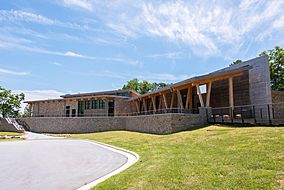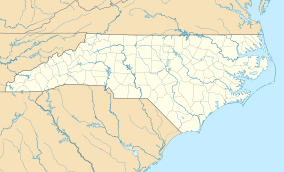Gorges State Park facts for kids
Quick facts for kids Gorges State Park |
|
|---|---|
|
IUCN Category III (Natural Monument)
|
|

Gorges State Park Visitor Center
|
|
| Location | Transylvania, North Carolina, United States |
| Area | 7,709 acres (31.20 km2) |
| Elevation | 1,900 ft (580 m) |
| Established | 1999 |
| Named for | Jocasee Gorges |
| Governing body | North Carolina Division of Parks and Recreation |
| Website | Gorges State Park |
Gorges State Park is a huge state park in Transylvania County, North Carolina. It covers about 7,709 acres (31.2 km²) of land. This park is part of a much larger area of protected land, stretching over 80 miles along the North Carolina and South Carolina border.
The state bought this land from a company called Duke Energy in 1999. Gorges State Park is the newest state park in North Carolina and is located in the western part of the state. It sits next to parts of the Pisgah National Forest and the N.C. Wildlife Resources Commission's Toxaway Game Land. The park is the main way to reach the Horsepasture River in these public areas.
Contents
Park History: From Flood to Forest
The land that makes up Gorges State Park is now a thriving second growth forest. This means it's a forest that has grown back after being cleared or disturbed by people. It has recovered well and now provides a special home for many plants and animals.
One big event that changed the Gorges area happened in 1916. A dam holding back Lake Toxaway broke. A huge amount of water rushed down the Toxaway River, destroying towns and leaving piles of debris up to 20 feet (6.1 m) high. The flood also deeply carved out the gorges.
After this big flood, local people sold large parts of the Gorges land to the Singer Sewing Machine Company. This company then cut down most of the trees. Later, in the 1940s and 1950s, Singer sold the land to Duke Energy. Duke Energy bought the land because its steep hills and heavy rainfall were perfect for building hydropower projects. These projects use water to make electricity.
Scientists started studying the Jocassee Gorge area in the late 1970s. In the late 1990s, Duke Energy decided they didn't need so much land for hydropower anymore. They offered to sell the land to natural resource groups in North and South Carolina. The NC Division of Parks and Recreation stepped in. With support from local people and the North Carolina General Assembly, they created Gorges State Park in 1999.
Fun Activities at Gorges State Park
Gorges State Park is open all year for many outdoor activities. You can go camping, hiking, mountain biking, and fishing here.
Camping Adventures
You can find primitive camping spots in different natural areas.
- The Ray Fisher Place campground is in the Grassy Ridge Access area. It's a hike-in campground, meaning you have to walk to it. Each of its six campsites has a picnic table, fire ring, and lantern hook. It's about a 0.75-mile (1.2 km) hike from the Rainbow Falls Trail-head.
- Another camping area is near Lake Jocassee. These spots are also primitive and hike-in.
- You can also do dispersed camping in the nearby Pisgah National Forest. Backpackers can register and leave their cars at the park.
Lake Jocassee is a deep, man-made lake that forms part of the park's southern edge. It's a great place for trout and bass fishing. All the streams in Gorges State Park are known for their Wild Trout Waters.
Trails for Everyone
The park has many miles of trails for hikers, mountain bikers, and horseback riders.
Grassy Ridge Access
The Grassy Ridge Access is the main entrance to the park. It's off North Carolina Highway 281 in Sapphire. This area is famous for being the best way to reach Rainbow Falls and Turtleback Falls on the Horsepasture River. Even though these waterfalls are actually in the Pisgah National Forest, many visitors think they are in Gorges State Park because the park provides the easiest way to get to them. Upper Bearwallow Falls is located within the park's access area, and it's the only waterfall in the park with a clear, maintained trail leading to it.
Frozen Creek Access
The Frozen Creek Access is the park's second entrance, located off Frozen Creek Road in Rosman. The park's longest trails start here. Both the Auger Hole and Cane Break trails begin at this access point and connect to different parts of the Foothills Trail. The Auger Hole Trail is special because it's a multi-use trail, meaning it's open to hikers, horseback riders, and mountain bicyclists.
A Special Temperate Rain Forest
Gorges State Park gets a lot of rain, over 80 inches (2032 mm) each year! This makes it a temperate rain forest. This heavy rainfall happens because of something called orographic lift. Imagine air moving over the land. When this air hits the tall mountains at Gorges State Park, it's forced to rise quickly, going up over 2,000 feet (609 m) in just 4 miles (6.43 km).
As the air goes higher, it cools down. Cooler air can't hold as much moisture as warm air. So, the moisture in the air turns into clouds, and then it rains a lot! This is why the park is so green and lush.
Amazing Nature and Wildlife
Gorges State Park has many different types of habitats. This is because of its varied rocks, different heights, and unique climate. Water from five streams in the park flows over the Blue Ridge Escarpment, creating beautiful waterfalls and deep gorges.
Rare Plants and Animals
The park is home to about 125 rare plant and animal species. It also has 12 species that are either endangered or threatened. Many of these rare plants, like Pringle's aquatic moss and Carolina star-moss, are usually found in tropical areas. Scientists are still trying to figure out how these plants ended up growing in the Appalachian Mountains, so far from their usual homes! Some think tiny spores might have blown in from the tropics. Others believe these plants have been here since a time when the area was much warmer.
Common Plants and Animals
Gorges State Park also has many plants and animals that are common in the southern Appalachians.
- Plants you might see include mountain laurel, rhododendron, white pine, red oak, and hickories.
- A very rare flowering plant called Oconee bells is found in large numbers in the park's gorges. These beautiful flowers are endangered, so it's special to see them here.
The most common animals you might spot in Gorges State Park are white-tailed deer, black bear, wild turkey, coyote, fox, and wild boar. The park is also home to North Carolina's largest known group of green salamanders. You might also find the rare Swainson's warbler bird and three rare fish: the turquoise darter, rosyface chub, and redeye bass.
Nearby State Parks
If you're exploring the area around Gorges State Park, here are some other state parks within 30 miles (48 km):
- Caesars Head State Park (South Carolina)
- Devils Fork State Park (South Carolina)
- Horsepasture State Natural River (North Carolina)
- Oconee State Park (South Carolina)
- Table Rock State Park (South Carolina)
Images for kids







